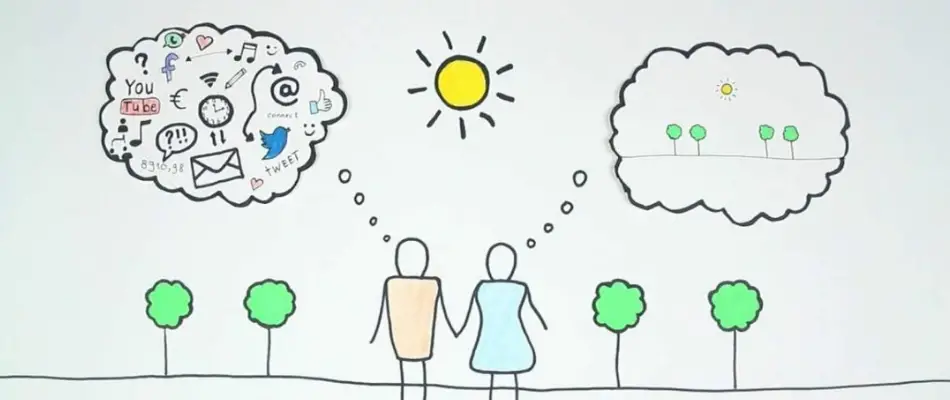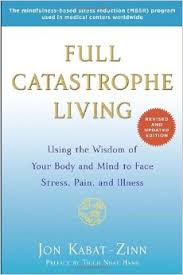It is extremely difficult to bridge the gap between the meditative state of mindfulness and tai chi practice. On one hand, doing the form feels good and we definitely feel better afterwards. But how do we answer questions from students, classmates, and ourselves about how to quiet the mind such as:
What should I be thinking about when I do the form? Does your mind race? Are you concentrating on something? How do I maintain a calm mind outside of class when I am not doing the form?
Mindfulness and tai chi share a direct connection because the deep breathing, open postures, and focus during slow movements increases awareness and the presence of mind that comes with concentrating on the current activities versus things like past regrets or future worries. Tai chi is a way to experience and practice mindfulness so that it can be transitioned into normal daily activities.
I will admit to you that I had historically been at a loss for providing a concise response that was satisfying. But I found a really solid answer. I was researching the relationship between mindfulness and tai chi and forgot I was reading on mindfulness because I read this:
To cultivate the healing power of mindfulness requires much more than mechanically following a recipe or a set of instructions. No real process of learning is like that. It is only when the mind is open and receptive that learning and seeing and change can occur. In practicing mindfulness you will have to bring your whole being to the process. You can’t just assume a meditative posture and hope that something will magically just happen, nor can you play a CD and think that the CD is going to “do something” for you. (p. 19*).
Doesn’t that sound like Tai Chi?
The leading researcher on Mindfulness, Jon Kabat-Zinn, speaks of major pillars of mindfulness that can be addressed simultaneously or individually to lead to a greater mental state. Through Wiseman‘s work we know that physical movement can produce desired emotional states. I will use this essay to interpret 5 of Zinn’s Pillars of Mindfulness in terms of doing the tai chi form. Let’s watch Jon Kabat-Zinn in these short explanations and then apply them to tai chi. Let’s start with some background history.
How did the Mindfulness Movement start?
The idea of mindfulness has gained so much traction in the last several years, even garnering an exclusive issue of Time Magazine. We couldn’t be more excited that conscious thought is now a buzzword. Yet, if we are left to believe that simply “being present” during daily activities leads to a calm mind, we risk moving backwards as a society. We don’t want people to become frustrated and dismiss consciousness as hogwash (again).

How did the Mindfulness Movement start? In the 1970s, Dr. John Kabat-Zinn applied principles of mindful meditation to patients in a medical setting. He developed the Mindfulness-Based Stress Reduction (MBSR) program which helped alleviate chronic pain and previously debilitating medical conditions, both physical and mental. His work studied the benefits of advanced meditation and worked to replicate the results in new comers.
He was indeed successful. However, most people championing the benefits of Mindfulness shrug off the main point. Zinn’s participants were successful by following a very strict, medically-tested protocol in a supportive community. They documented improvements in health markers and well-being after several weeks of consistent study so it is not enough to say “be present while you chew your carrots.”
Kabat-Zinn’s work is nothing short of avant garde and brilliant considering that it took place almost half a century ago at a time when western medicine was not receptive to alternative approaches. He brought eastern thinking into the western medical community and demonstrated results that could be replicated. If you are truly interested in understanding Mindfulness, then reading his Full Catastrophe Living is a must. At the very least, watch his videos where he speaks on the 5 pillars of mindfulness (non-judging, patience, beginner’s mind, trust, non-striving). Your progress will be less watered-down with this basic understanding.
For more on Jon Kabat-Zinn and his work refer back to this essay: What is Meditation and Why Should I Meditate?
Mindfulness and Tai Chi
1. Non–judging
The overlap between mindfulness and tai chi is exact when considering non-judgement. Judging creates a steady stream of primarily negative thoughts that makes it nearly impossible to quiet the mind. Mindfulness and tai chi is not an end to being judgmental, its a recognition of the thinking and getting clarity and noticing the tendency to judge which doesn’t allow us to see things as we are.
2. Patience
Patience ties mindfulness and tai chi together because it can take years to learn the tai chi form well. Practicing tai chi cultivates patience and lets things unfold in its own way. It takes a long time to learn tai chi because the body is simultaneously undoing old patterns and creating new. This is healing and restorative not only from a physical perspective as we heal old injuries or improve posture but in a mental capacity and we do not react or think in old ways.
3. Beginner’s Mind
I believe that beginner’s mind is actually taken from the martial arts so in a way it’s an acknowledgement by Kabat-Zinn that both mindfulness and tai chi share the same roots. It is something we can bring to any moment. However, we operate out of habit during our day-to-day life and doing the tai chi form gives us a way to practice quieting the mind. This way we can experience it and then have a better idea of what to look throughout the day.
4· Trust
Trust is an attitude that we typically think about in our relationships to others. Mindfulness and tai chi take this idea and turn it inward and focus on the body. There are so many ways we trust our body to breathe and see and keep us moving. Cultivating this trust that things are going on without our need to intervene gives us a sense of calm that things will carry on and be alright. It is easier to think about with our physical body and can be cultivated by practice.
5. Non-striving
The goal of non-striving that is part of any practice that awareness is very foreign to westerners. It is the idea of allowing things to happen and simply acknowledging the without acting on them. Just letting things be as they are. Tai chi gives us a window of time to just focus on the moves we are doing. Even if it is not good enough, even if you have other things that are stressing you out. You can take a few minutes and just move through the tai chi form, in whatever capacity you are able to accomplish it today.
“The attitude with which you undertake the practice of paying attention and being in the present is crucial. It is the soil in which you will be cultivating your ability to calm your mind and to relax your body, to concentrate and to see more clearly. If the attitudinal soil is depleted, that is, if your energy and commitment to practice are low, it will be hard to develop calmness and relaxation with any consistency. If the soil is really polluted, that is, if you are trying to force yourself to feel relaxed and demand of yourself that “something happen,” nothing will grow at all and you will quickly conclude that “meditation doesn’t work.”
*Full catastrophe living: using the wisdom of your body and mind to face stress, pain, and illness Jon Kabat-Zinn – Pub. by Dell Pub., a division of Bantam Doubleday Dell Pub. Group – 1991

How to Quiet the Mind : 4 Factors that May Be Holding Us Back
Do you have a mind that races endlessly? Join the club, right? Stopping the brain’s eternal discourse might not be entirely possible but know that there are people who experience less of it, they do experience breaks in thinking, and their thoughts are genuinely happier. Here are four reasons why you may not have been as success at quieting the mind as you would like:
1. Most resources try to quiet the mind by treating it as a single topic with a single cure
As this essay suggests, we are capable of a quiet mind and enjoying a variety of benefits. Unfortunately, nearly all available resources treat this as one singe dense topic. When we research what people really want from a focused, quiet mind, we uncover that most of our desires fall into 6 distinct camps:
- I want my thoughts to stop racing and stop causing stress and anxiety so that I can sleep well again.
- I want the endless negative chatter in my head to stop.
- I want to improve my thoughts to take the power out of negative emotion.
- I want my mind to slow down or stop racing. I wish I had an “off button.”
- I want to reduce all of the negative input that my mind receives from other people and the news because I realize that it puts me in a bad place.
- I want to increase my ability to focus.
Can the person who suffers from negative chatter also want to increase their ability to focus? Sure. But if we talked to these people, what would their chief aim be? Would every person want to increase their focus to increase their income? Be happier? Improve their relationships with coworkers and friends? No. Eventually, one activity (meditation) can enhance all of these desires simultaneously. But on the front end we need distinct activities to address specific afflictions. We need the right tool for the right job.

2. Most suggestions on mindfulness and quieting the mind are decoupled from our daily situation
We are told that practices like meditation, religion, tai chi, or yoga, are good for quieting the mind, enhancing our focus, and improving our well-being. On a minor level, we are instructed on how to be mindful or spiritual during daily activities such as eating, walking, or interacting with our kids. These practices and traditions truly are beneficial. But precious little is said about how to distill often arcane or esoteric information and apply it when we are suffering the most.
As an example, I have been practicing and studying martial arts for over 20 years. In the first five or so years, training was enjoyable and definitely had a positive impact on my life. But the calmness and clarity I enjoyed during practice had zero carryover into my relationships, work, or schooling. I might as well have been studying boxing if I wanted martial ability or played soccer if I wanted a workout and sense of community. Who I was in class or meditation was not who I was outside of that one-hour block.
Meeting high level practitioners and seeing how they ran their lives, businesses, and interacted with the families changed all of this. Yes, they practiced. But they put their learning up against real activities in their daily lives. They “practiced” while washing the dishes, driving, or folding laundry just like all the magazine articles touting awareness and mindfulness suggest. However, they also had strategies to really “practice” when they got tested during times of injury and stressful life and work events.
If you undertake mindfulness activities, meditation, or active arts like tai chi or yoga, and wait for some great advancement, you may be waiting a long time. I believe these arts are designed to give you a sense of well-being and clarity. But you must then seek to reproduce these experiences outside in the real world. So, if we are going to quiet the mind successfully, your strategies and practices cannot be separate from the very life events and thoughts that are causing the difficulty in the first place.
3. Our brain is largely untrained
Let’s say you bought a puppy. Would there be any expectation that your new dog would learn how to sit, behave, or go to the bathroom outside without training? Of course not. And if you decided to try and skip the training what would happen? He would be bonkers and probably create havoc in your life. A mind untrained acts a lot like this puppy.

Your puppy is nutso – you train the puppy. Your mind is nutso, you… do nothing if you are like most people because we don’t realize that the mind is indeed trainable. Through a simple, small accumulation of changes you can begin quieting the mind. The trouble is that most of us have never actively taken steps to do this. Maybe because up until this point we thought it was too hard or outside of our control. Or maybe taking control of the mind was seen as something just for people with psychological problems or something out of science fiction via hypnosis or mind control.
The idea that the mind is trainable should excite you. It means that you are not nuts, negative, weak, or broken. Just untrained. You need to get to work on finally addressing the problem (the training) head on. If you really struggle with uncontrollable thoughts sometimes it’s frustrating at the beginning to just “be mindful.” There are two ways to help you getting over the initial hump. Some people are more successful when they use meditative tones so they have something to do an focus on, or listening to binaural beats to help calm the over-thinking.
4. Our brain is wired with a bias towards negativity
Survival has always been dependent on us paying attention to, and remembering bad events. If something threatened the survival of our ancestors, a memory needed to be formed immediately and vividly so that the pattern was not repeated. Makes complete sense, for them. But is it still serving us today?
“The brain is very good at learning from bad experiences and bad at learning from good ones.”
Dr. Rick Hanson
Think about someone you interacted with yesterday. If you had 10 positive interactions, 9 neutral, and 1 negative, which do you carry home with you? Last year at your job, out of all of the compliments and criticisms you received, which do you remember? Of all the relationships you have been in, can you more readily recall the people you broke up with or the people who broke up with you?

Bad experiences have direct access to the emotional and memory portions of our brain. This negativity bias creates a barrier to healing, growing, and learning. Basically, when you try something new you will more readily imprint the negative experiences that you have than the good ones.
So if we are going to increase our chances at succeeding at something new, we need a way around the negativity of the brain, right? The answer lies in how the brain imprints positive thoughts and memories.
Positive thoughts and memories have distinct criteria. A positive thought is 1) imbued with positive emotion, that is 2) felt physically at the same time it is thought mentally, for 3) a reasonable duration of time (at least 10-20 seconds). Any solution to ending negative mental chatter needs to incorporate mental, emotional, and physiological aspects in order to be successful. Most activities available to us to combat our negative mind are not this comprehensive.
Want Help Learning How to Quiet Your Mind?
Readers of Tai Chi Basics consistently ask for resources for how to tie what they are learning in tai chi to what is going on in the rest of their life. One way of have been able to quiet my mind and connect what I have learned from mindfulness and tai chi practice is by using binaural sounds when I am working. I am actually using them right now as I right this! It’s a way to use nice sounding music to help push the brain into a natural rhythm that feels like a a nice flow state. I use Focus@Will and you can read more about how I us it here.





i agree with almost every thing of this post, but…
taijiquan is a fake. and cannot delivers what it promises
what exists for more than 400 years is QIgong (with various names)
and taiji is a martial adaptation of qigong movements (see magwandu findings.
i recommend less faith and more study
Hi Jacques,
Thank you for writing. I will return the compliment and say that I agree with almost everything in your comment. Considering taiji a form of qi gong is pretty acceptable based on their inherent goals and the martial adaptation of moves is well documented. Taiji does deliver what it promises to those with good instruction. Practitioners in China and many in the US and UK are benefiting substantially. However, the information that we have had access to and level of instruction that many have received are not at this level. With the dawn of the internet and changes in our relationship with China which has led to increases in visits (both ways) and exchanges this is all changing. This is the purpose behind this blog if you want the truth. To tangibly share insights that lead to results.